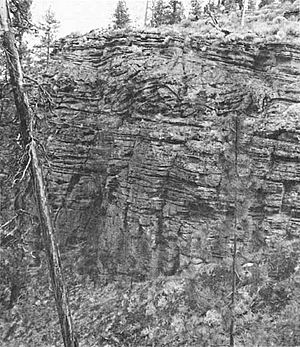Big Hole (Oregon) facts for kids
Quick facts for kids Big Hole |
|
|---|---|

East rim of Big Hole, Oregon.
|
|
| Location | Lake County, Oregon, U.S. |
| Coordinates | 43°25′30″N 121°18′48″W / 43.4251292°N 121.3133502°W |
| Range | Cascade Range |
| Elevation | 4,613 feet (1,406 m) at the bottom |
| Geology | Maar |
| Age | Possibly 20,000 years |
| Topo map | USGS Big Hole |
Big Hole is a huge hole in the ground in Oregon. It's a special type of crater called a maar. A maar is formed when hot magma deep underground meets groundwater. This causes a massive steam explosion!
Big Hole is located in Lake County, Oregon, in the central part of Oregon, U.S.. It's not far from Crater Lake. This giant hole is about 6,000 feet (1,820 meters) wide. It's also around 300 feet (91 meters) deep. Big Hole is close to another interesting crater. This one is called Hole-in-the-Ground.
Contents
What is a Maar?
A maar is a wide, flat-bottomed volcanic crater. It is usually filled with water to form a lake. However, Big Hole is dry. Maars are formed by a specific type of volcanic eruption. This eruption happens when hot magma comes into contact with groundwater.
How Maars are Formed
When magma (molten rock) rises close to the Earth's surface, it can heat up underground water. This water turns into steam very quickly. The steam expands with incredible force. This causes a huge explosion that blasts through the ground.
The Explosion Process
The explosion creates a large, bowl-shaped crater. This crater is often surrounded by a low rim. This rim is made of rock and ash. These materials were thrown out during the explosion. Over time, the crater can fill with water, forming a maar lake.
Big Hole's Location and Age
Big Hole is found in an area called the Fort Rock Basin. This basin is in Lake County, Oregon. The area is known for its many interesting volcanic features. Big Hole is thought to be quite old. Scientists believe it might be around 20,000 years old.
Nearby Volcanic Features
The region around Big Hole has many other volcanic landforms. These include other maars and cinder cones. This shows that the area has a long history of volcanic activity. These features help scientists understand how the Earth changes over time.
Hole-in-the-Ground
Close to Big Hole is another maar called Hole-in-the-Ground. This crater is smaller than Big Hole. However, it is less eroded. This means it looks more like it did right after it formed. Studying both craters helps scientists learn about how maars change over thousands of years.
Exploring Big Hole
Big Hole is a natural landmark. It is located near Oregon Route 31. This makes it somewhat accessible for visitors. The area offers unique views of a large volcanic crater.
Natural Environment
The landscape around Big Hole is typical of central Oregon. It includes dry grasslands and scattered trees. This environment supports various types of wildlife. Visitors might see deer, rabbits, and different bird species.
Protecting the Area
As a natural feature, Big Hole is important for scientific study. It also provides a habitat for local wildlife. Protecting these areas helps preserve them for future generations. It also allows scientists to continue learning about Earth's geological past.

